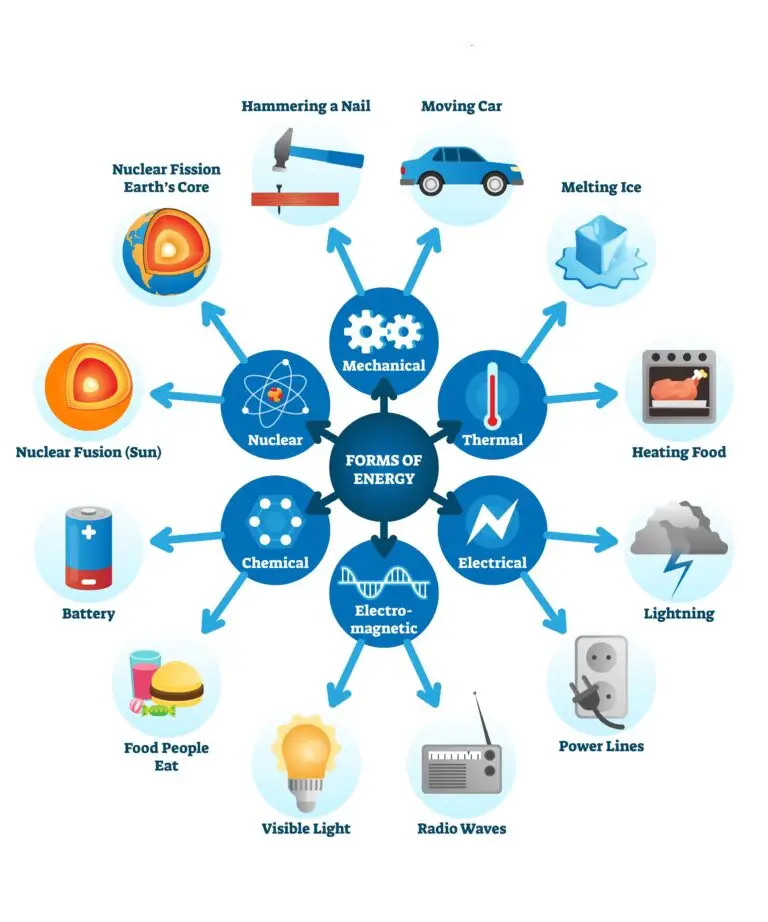Energy

Table of Contents
What is Energy?
Energy is defined as the ability or capacity of a system to perform work. Work, in this context, refers to the transfer of energy from one system to another, resulting in a change in the state or condition of the system.
Energy manifests in various forms, including kinetic (due to motion), potential (stored energy), thermal (heat), chemical (stored in chemical bonds), electrical (due to electric charges), nuclear (stored in atomic nuclei), and many others. These forms can be converted from one type to another, but according to the energy conservation law, the total energy remains constant in an isolated system.
Forms of Energy
Kinetic
Kinetic energy is the energy associated with the motion of an object. The kinetic energy of an object depends on its mass and velocity, following the formula:
KE=\frac{1}{2}mv^2
where ��KE is kinetic energy,
�m is mass,
and �v is velocity.
Potential
Potential energy is stored energy that an object possesses due to its position, state, or configuration. Common types of potential energy include gravitational potential energy (related to height), elastic potential energy (related to deformation of objects like springs), and chemical potential energy (related to chemical bonds).
Thermal
Thermal energy is a form of energy related to the temperature of a substance, reflecting the kinetic energy of its particles, such as atoms and molecules. The faster these particles move, the higher the thermal energy and, consequently, the temperature of the substance.
Electrical
Electrical energy is a form of energy that results from the movement of charged particles, such as electrons, through a conductor. This type of energy is fundamental to modern life, powering homes, businesses, and various technologies. When electric charges flow through a material, they transfer energy from one point to another, creating electrical energy that can be harnessed for various uses.
Light
Light energy, a form of electromagnetic radiation, encompasses a range of wavelengths and frequencies that include not only visible light but also ultraviolet (UV) light, infrared (IR) radiation, and other types of electromagnetic waves.
It is essential for life on Earth, driving processes like photosynthesis in plants, influencing weather and climate patterns, and playing a key role in vision. It also has numerous practical applications, including communication (fiber optics), medical treatments (laser surgery and phototherapy), and energy production (solar power).
Nuclear
Nuclear energy is released during nuclear reactions such as nuclear fission (splitting of atomic nuclei) or nuclear fusion (combining of atomic nuclei). It is a potent source of energy used in nuclear power plants and nuclear weapons.
It’s immense power makes it a key resource for generating electricity, providing a significant amount of the world’s energy supply. However, it also raises important considerations regarding safety, waste management, and environmental impact, especially given the potential for radiation release and the long-term storage requirements for nuclear waste.
Conservation of Energy
According to this law, energy can be transformed from one form to another, but the total energy within the system remains unchanged. In any process, energy changes form to suit the needs of that process without any loss in the total amount of energy.
For instance, in a hydroelectric power plant, potential energy of water stored in a dam is converted into kinetic energy as the water flows down, which is then transformed into mechanical energy by turning turbines, and finally into electrical energy through generators.
The concept applies strictly to closed systems, where no energy is exchanged with the surroundings. In such systems, the total energy before and after any process or reaction remains the same, although it may manifest in different forms.
For example, in a closed chemical reaction system, the chemical energy might be converted into thermal energy, but the sum of both forms of energy will remain constant.
Sustainability and Energy Conservation
Sustainability and energy conservation are critical issues in the context of environmental stewardship and resource management. As global awareness of environmental sustainability and the consequences of resource depletion rises, there’s a concerted effort to focus on energy conservation and the pursuit of more efficient and sustainable energy solutions.
This involves reducing energy consumption through various means, such as using energy-efficient appliances, improving insulation in buildings, and adopting practices that reduce electricity and fuel use. Conservation efforts not only save energy but also decrease the overall demand for energy production, which can reduce the strain on natural resources and decrease pollution levels.
Renewable and clean energy technologies include transitioning from fossil fuels to renewable energy sources such as solar, wind, hydro, and geothermal is central to sustainable energy policies. These renewable sources are considered clean because they produce little to no greenhouse gas emissions or pollutants compared to traditional fossil fuels.
Related Links
Convection
Exothermic Reaction
Friction
Respiration